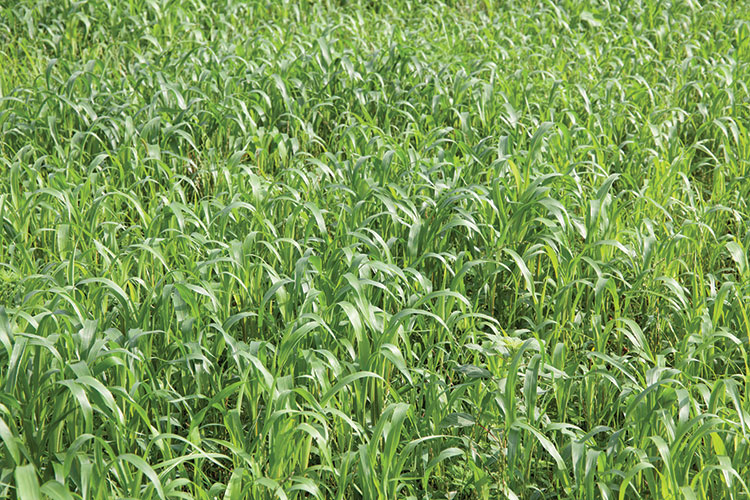Capture energy per acre with alternative forages |
| By John Goeser |
|
Alternative forages may be profitable, but digestible energy per acre is key to their true value. |
The author is the director of nutrition research and innovation with Rock River Lab Inc, and adjunct assistant professor, University of Wisconsin-Madison’s Dairy Science Department.  Alternative forages may be profitable, but digestible energy per acre is key to their true value. Leading growers, for dairy or feedlot forage, think in terms of energy harvested per acre instead of tons. This sounds complex, but with alternative forages such as sorghum, we can work toward estimating energy by quantifying total digestible tons harvested as opposed to raw tons per acre. Energy and digestible tons (with corn, sorghum, sudangrass, milo, millet, and other cereal forages) are largely digestible carbohydrates from fiber, starch, and sugar. I’ve recently worked through this effort with two leading dairy consultants and their clients, who work in the southern and western United States. Across these areas, and most of the U.S., dairy and feedlot margins are tight. Class III milk value balanced against labor, feed, and other fixed costs is hovering around or below breakeven for much of the next 12 months. Further adding to economic hardship, water costs can be extreme in the South and West. The topic in these conversations has been investigating value per acre with brown midrib (BMR) or conventional cereal silages such as sorghum, sudangrass, milo, and millet. Our aim needs to be squeezing more milk or meat out of each ton of feed and acre. Digestion is complex Quantifying tons per acre and moisture is straightforward, hence many growers, farm owners, and managers take the easy road and get excited about big yields. However, quantifying and understanding digestible tons is where your dairy or feedlot profitability potential exists. So, why don’t many move toward this yield measure? This is a complex proposition because total tons need to be balanced against rumen and total tract carbohydrate digestion. Quantifying digestion is difficult to grasp and build into projections. Nutrition experts have been working in this area though, and newer research is helping us better understand digestibility. So, let’s explore how we can assess fiber and starch’s true value. With fiber, David Combs, dairy scientist with the University of Wisconsin, has developed a research backed and validated forage test measure that forecasts total tract fiber digestion (TTNDFD). The beauty in the Combs’ model is that several measures are combined into a single measure, which is easy to interpret across all forages — 42 percent TTNDFD is average, and the aim is 48 percent or better for optimal milk production or weight gains. A 42 percent TTNDFD means that 4.2 pounds of every 10 pounds of fiber fed is digested and used by the cow. Many consider TTNDFD to be “RFQ on steroids” in terms of forecasting fiber potential in dairy cows. With starch, the industry still has much to learn. Grain and starch digestibility is a function of genetics, growing conditions, fermentation, and processing. With the focus here being berry-yielding forages, the berries are known to be hard. The starch value in many cases is completely discounted to zero by consultants because the grains are not easily processed or digested. Harvesters can help unlock additional energy per acre, though, by using special berry processors on self-propelled choppers and break the berries for better starch digestion. Researchers at Kansas State University have given us a tool to benchmark berry processing (berry processing score, BPS); the goal is a score of better than 50 percent. The BPS has been shown to correlate with starch digestion, with adequate processing leading to 80 percent rumen starch digestion, which is the goal. This means that for every 10 pounds of grain in the diet, 8 pounds are digested in the rumen. Further, forage testing laboratories can directly assess starch digestibility using either rumen in situ starch digestion or fecal starch content techniques, both of which have been shown related to cattle performance. So, using either BPS or directly assessing starch digestion can be paired with TTNDFD on a forage analysis to help project carbohydrate digestibility. Figure energy per acre With both fiber and starch digestion measures better quantified, then your advisory team can more easily balance these values against nutrient and yield measures to estimate digestible carbohydrate yield per acre. Fiber (neutral detergent fiber [aNDF]) and starch contents can be multiplied by TTNDFD (percent of aNDF) and rumen in situ starch digestion (isSD7, percent of starch) to yield digestible fiber and starch content (percent of dry matter [DM]). Next, the yield (DM tons) can be multiplied by the sum of digestible fiber and starch to quantify digestible DM carbohydrates per acre. This value then represents what cows or cattle can actually utilize per acre. This is a much more accurate tonnage value to use in economic projections when balancing against input costs per acre such as seed, water, and fertilizer. Profitable opportunities may exist for your fields with alternative forages; however, consider advancing your understanding of the energy quantity harvested per acre. Collaborate with your seed consultant, crop adviser, harvest crew, and nutrition consultants in estimating your alternative crop’s true value per acre. Measuring digestible carbohydrate yield per acre rather than raw tonnage will be the best indicator of dairy or feedlot economic return per acre. This article appeared in the November 2017 issue of Hay & Forage Grower on page 20. Not a subscriber? Click to get the print magazine. |
